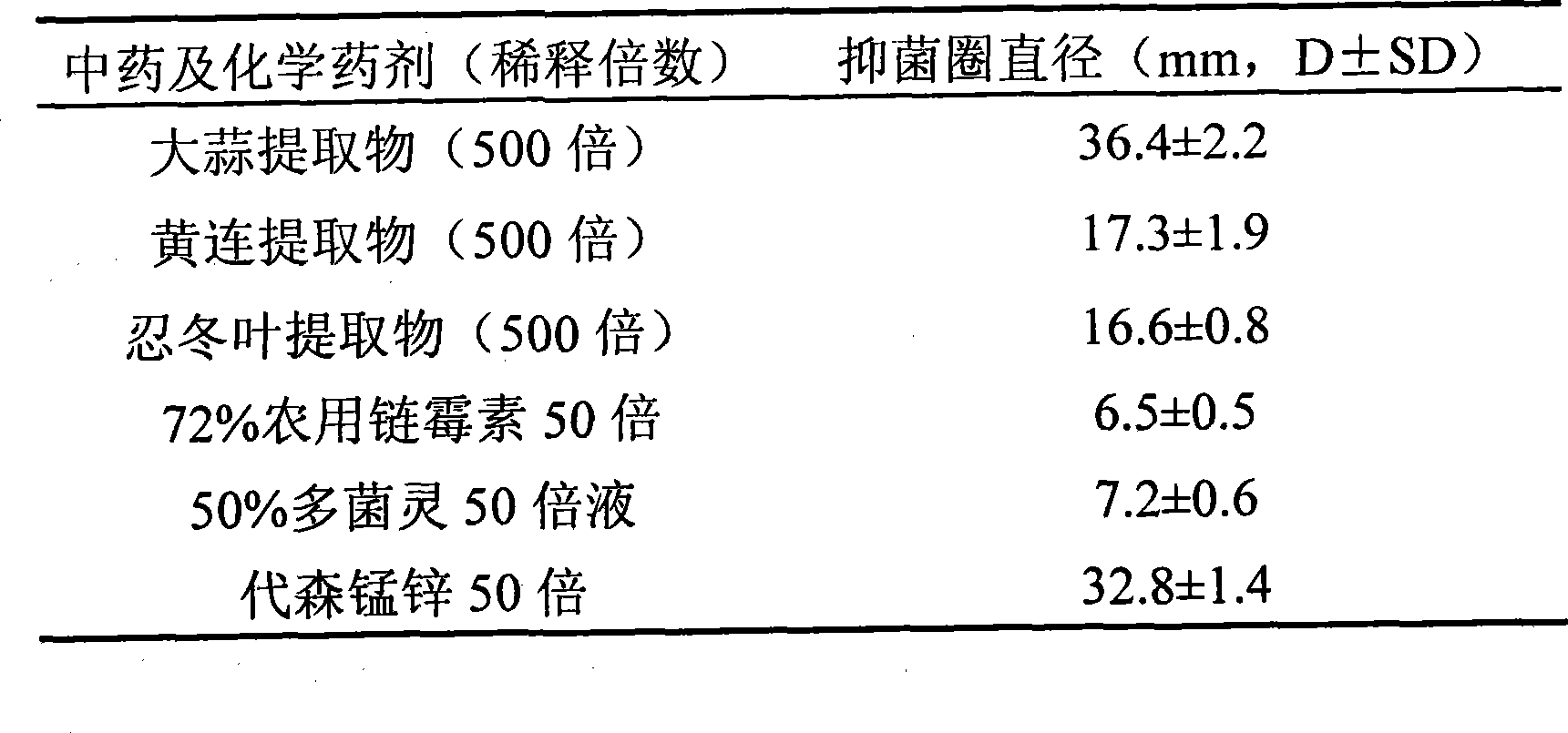Chinese medicine bactericidal agent for preventing and treating soft rot of konjak
A fungicide and soft rot technology, which is applied in the field of traditional Chinese medicine fungicides for the prevention and treatment of konjac soft rot, can solve the problems of affecting the killing effect of the pathogenic bacteria of konjac soft rot, and the lack of pertinence, so as to slow down drug resistance Production, strong specificity, and the effect of increasing drug resistance
- Summary
- Abstract
- Description
- Claims
- Application Information
AI Technical Summary
Problems solved by technology
Method used
Image
Examples
preparation example Construction
[0025] 4) Preparation of wettable powder: mix 3% to 12% of Coptis chinensis extract and 3% to 10% of honeysuckle leaf extract by weight percentage, dry at 80°C for 1 hour, crush through a 200-mesh sieve, and then add wettability After adding 3% to 5% of powder additives and 36% to 70% of filler carrier, put it in a mixer and stir it fully for 1 hour, while stirring, add 12% to 36% of garlic extract until all components are completely mixed evenly.
[0026] The method of using the traditional Chinese medicine fungicide of the present invention is to mix the wettable powder of the traditional Chinese medicine fungicide 200 to 500 times with water according to the weight ratio, and then use it for soaking the seeds of konjac taro, root irrigation and spraying of konjac plants, generally Apply 400 grams of traditional Chinese medicine fungicides per mu.
Embodiment 1
[0029] (1) Prepare garlic, coptis and honeysuckle leaf extract respectively
[0030] After peeling, Enshi produces 10 kg of fresh white-skinned garlic, wash it, add 3 kg of water, beat it with a beater for 0.5 hours to get garlic paste, pour it into a sealed tank, add 0.02mol / L hydrochloric acid dropwise and keep stirring until the pH of the garlic paste =6.0, sealed and kept at a temperature of 40° C., allowing the endogenous Alliinase in the mashed garlic to enzymatically hydrolyze alliin for 4 hours to produce allicin. After the enzymolysis is completed, the garlic paste is transferred to a stirring tank, and 40 kg of 95% edible ethanol is added, and after fully stirring, the allicin extract is obtained by filtering through a small stainless steel plate frame filter, and transferred to a vacuum decompression concentration tank, controlled The distillation temperature was 60° C., the vacuum degree was 0.01 MPa, and concentrated until no water was evaporated to obtain 0.43 kg...
Embodiment 2
[0040] Purchase 200 kilograms of fresh white-skinned garlic produced in Enshi, and obtain 9.22 kilograms of garlic extract according to the preparation method in Example 1 after peeling (the content of allicin in the extract is 6.36% through high-performance liquid chromatography); kg, obtain 5.84 kg of Coptidis Rhizoma extract according to the preparation method in Example 1 (the berberine content in the extract is detected by high-performance liquid chromatography to 33.10%); 50 kg of dry honeysuckle leaves produced in Chongqing, obtain Lonicera Lonicera according to the preparation method in Embodiment 1 9.50 kg of leaf extract (the content of chlorogenic acid in the extract is 15.79% as detected by high performance liquid chromatography).
[0041] Take 2.00 kg of Coptis chinensis extract and 1.80 kg of honeysuckle leaf extract, mix them, dry at 80°C for 1 hour, crush them through a 200-mesh sieve, add 0.80 kg of calcium dodecylbenzenesulfonate, alkyl aryl polyoxypropylene p...
PUM
 Login to View More
Login to View More Abstract
Description
Claims
Application Information
 Login to View More
Login to View More - R&D
- Intellectual Property
- Life Sciences
- Materials
- Tech Scout
- Unparalleled Data Quality
- Higher Quality Content
- 60% Fewer Hallucinations
Browse by: Latest US Patents, China's latest patents, Technical Efficacy Thesaurus, Application Domain, Technology Topic, Popular Technical Reports.
© 2025 PatSnap. All rights reserved.Legal|Privacy policy|Modern Slavery Act Transparency Statement|Sitemap|About US| Contact US: help@patsnap.com


